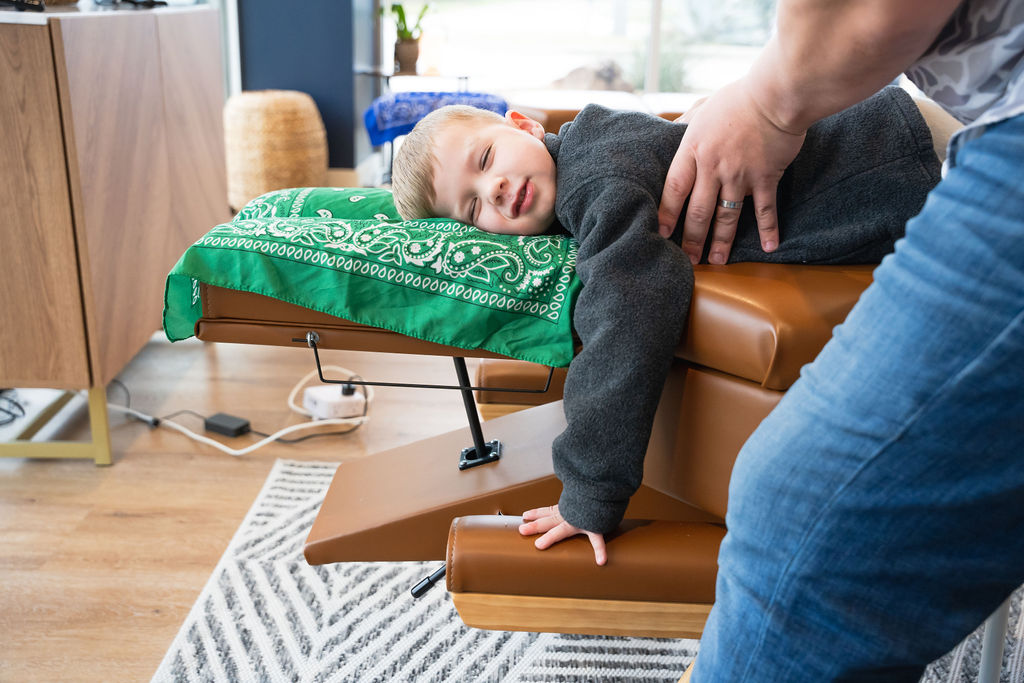Back-to-School Tips for a Healthy Nervous System: Ignite Your Child’s Resilience This Year

Why Back-to-School Season Challenges the Nervous System
Back-to-school season can feel like someone flipped a switch—one day, your child wakes up to slow mornings and backyard adventures; the next, alarms buzz at dawn and new routines demand instant focus. This abrupt shift doesn’t just affect your family’s schedule. It creates real, measurable changes in your child’s nervous system health, especially in how their body responds to stress and adapts to new demands. Researchers have found that transitions—especially those involving early wake-ups and increased social interactions—can elevate cortisol, the primary stress hormone, by up to 30% in school-aged children during the first month of school. These stress responses may show up as more than just “first week jitters.”.
The Abrupt Switch: From Summer Freedom to Structured Schedules
Summer’s rhythm invites relaxation, spontaneous play, and plenty of sleep; the nervous system (your body’s “fuse box” that controls how you adapt to life) thrives under these conditions. However, as August arrives, most families must quickly switch gears. Suddenly, your child’s brain faces new expectations: wake up earlier, sit still for longer, and keep up with a packed calendar. Studies show that losing just one hour of sleep per night—common during school transitions—can reduce kids’ emotional regulation and focus by more than 20%.
This isn’t just about being tired. When the nervous system is stretched too thin, it can get “stuck” in survival mode: quick to react, slow to recover. For families in Cypress, TX, and nearby communities like Bridgeland, Katy, and Tomball, these shifts can feel even more intense if your child already struggles with sensory overload, chronic tummy aches, or frequent colds.

Understanding the School Stress Load—Early Wake-ups, Packed Classrooms, New Social Dynamics, and Homework
Each school day introduces a cascade of stressors that require your child’s nervous system to constantly adapt. Early alarms disrupt sleep cycles, packed classrooms amplify noise and reduce personal space, and shifting friendships can trigger anxiety or uncertainty. Add in homework and after-school activities, and it’s no wonder many kids experience overwhelm before September ends.
One local parent shared with us that her seven-year-old son, who loved summer camps, started dreading school mornings—complaining of stomachaches and feeling “foggy” by lunchtime. Pediatricians recognize this as “adaptive energy” depletion; the body only has so much capacity to handle change before it starts sending out warning signals. At Ignite Chiropractic, we see these patterns every August. The good news? With the right student wellness tips, families can help kids reset, so their brains and bodies can thrive instead of just survive.
Common Symptoms of Nervous System Overload in Kids—Trouble Sleeping, Digestive Upsets, Emotional Swings, Focus Issues, and Recurring Immune Challenges
When the nervous system’s “fuse box” is overloaded, symptoms can show up in surprising ways. Trouble falling asleep, frequent nightmares, or bedwetting often surface in the first weeks back at school. You might notice your child complains of tummy pain after lunch, mood swings during homework time, or a sudden spike in sniffles and coughs—these are all signs that the nervous system is struggling to adapt to new stressors. In fact, the CDC reports that anxiety and sleep disturbances now affect more than 1 in 5 elementary-aged children in the U.S., especially during major transitions.
If you’ve seen these red flags in your own home, you’re not alone. Our team encourages parents to decode your child’s symptoms so you can catch early signs of overload before they turn into bigger issues. For a deeper dive into specific symptoms and their root causes, explore our guide on common symptoms of nervous system overload.
Supporting your child’s back to school health goes beyond packing a healthy lunch—it’s about recognizing when their system needs a reset, and finding proactive ways to nurture resilience. Every adjustment, every act of support, helps your child’s light burn brighter through the school year’s challenges.
Foundations of a Resilient Nervous System: Sleep, Nutrition, and Movement
Back-to-school transitions challenge every child’s adaptability, but the right daily rhythms can “dim the chaos” and nurture a healthy nervous system from the inside out. Imagine your child’s brain-body connection as a dimmer switch—when you support it with intentional sleep, nutrition, and movement, you dial down overstimulation and turn up resilience. This approach doesn’t just help kids feel calmer in the classroom; it helps the entire family move from survival mode to true connection and vitality. If you’re searching for healthy nervous system tips or student health tips that actually work, start with these foundational habits.
Sleep Routines that Reset and Restore—bedtime cues, tech curfews, and why 10 extra minutes of morning light matters
Consistent sleep routines set the stage for emotional regulation and focus—especially during stressful transitions like the first week back to school. Pediatric sleep experts agree that kids need 9–12 hours of quality sleep per night, depending on age. That’s not just a number; it’s a nightly reset for the nervous system, allowing the body to repair and the brain to process learning. One simple, science-backed strategy: use a “tech curfew” by powering down screens at least 30 minutes before bed, since blue light can delay melatonin (the sleep hormone) and disrupt deep rest. Adding a bedtime cue, like a familiar story or gentle stretching, signals to your child’s brain that it’s safe to shift into rest mode. In the morning, step outside for at least 10 minutes of sunlight—this anchors their circadian rhythm, boosting mood and alertness for the entire day. For more on building healthy sleep routines for kids, visit our dedicated guide.
Fuel that Calms and Energizes Growing Brains—protein-rich breakfasts, hydration hacks, and balancing blood sugar for stable moods
Nutrition acts as the nervous system’s fuel source, and even small upgrades can make a big difference in kids nervous system health. Research shows that children who eat a protein-rich breakfast—think eggs, Greek yogurt, or nut butter—stay focused longer and experience fewer morning meltdowns. Stable blood sugar is key: when it dips, irritability and brain fog spike. Try pairing complex carbs (like whole grain toast) with protein to slow sugar absorption; this keeps your child’s energy and mood steady until lunch. Many parents overlook hydration, but the brain is over 70% water, and even mild dehydration can cause fatigue and distractibility. A fun water bottle and a chart for tracking ounces can motivate kids to sip throughout the day. Curious how balanced meals support emotional steadiness? Check out our tips for balancing blood sugar for stable moods.
Movement that Integrates Body and Mind—brain-gym exercises, recess strategies, and family stretching rituals that prime the Zone Technique’s six systems
Movement isn’t just for burning energy; it’s the glue that helps the brain and body communicate—especially as children adapt to new routines. Short bursts of “brain gym” activities (like cross-crawls, which involve touching the right elbow to the left knee) have been shown to activate both sides of the brain, sharpening focus and coordination. If your school offers limited recess, advocate for active breaks: just five minutes of jumping jacks or a brisk walk can reset a frazzled nervous system. At home, try a stretching ritual before dinner, such as reaching for the sky or gentle twists, to help everyone unwind and reconnect. These habits don’t just ease tension; they prime the six systems addressed by the Zone Technique’s six systems, supporting everything from digestion to emotional balance. For families seeking deeper understanding, our guide to decode your child's symptoms reveals how the nervous system’s signals point to what your child truly needs.
If you’re a parent in Cypress, TX or nearby areas like Bridgeland, Katy, or Tomball, these healthy habits for students returning to school can transform not only your child’s day but your entire family’s wellness journey. Ignite Chiropractic believes these practical steps nurture adaptability, spark resilience, and help kids thrive—at school, at home, and beyond.
Daily Nervous System Regulation Techniques for Students
Supporting your child’s nervous system doesn’t require hours out of your day—it’s about building simple rituals that fit into backpacks and busy mornings, helping kids face back-to-school transitions with more calm and confidence. Students today encounter more sensory input and emotional stress than ever, yet you can equip your family with practical, science-backed nervous system tips for students that truly work, even on the most hectic school days. When you provide your child with these daily nervous system regulation techniques, you empower them to “flip the switch” on resilience, focus, and emotional steadiness—qualities that impact not just grades, but friendships and family harmony, too.
Morning Activation Rituals—3-Minute Spinal Warm-Ups and Affirmations That ‘Ignite the Fuse Box’ for the Day
Think of your child’s nervous system as a fuse box that controls every room in the house; if one circuit is overloaded or “blown,” the whole household feels it. Quick spinal warm-ups, like gentle cat-cow stretches or rolling the shoulders back and forth, help “reset the circuits” before your child even grabs their backpack. A study published in the Journal of Chiropractic Medicine (2022) found that just three minutes of intentional movement in the morning improved focus and decreased stress hormones in school-aged children. For families rushing out the door, pair these movements with a simple affirmation—“I am safe, I am strong, I am ready”—to prepare your child’s brain and body for whatever the day brings. These small rituals can spark a big shift in classroom readiness.
Midday Reset Practices—Box Breathing, Water Breaks, and Sensory Grounding Tools to Prevent Afternoon Meltdowns
By lunchtime, many students—especially those with sensory sensitivities or anxiety—show signs of nervous system overload: irritability, fidgeting, or emotional outbursts. Box breathing (a technique involving slow inhaling for four counts, holding for four, exhaling for four, and pausing for four) has been shown to lower cortisol (the stress hormone) and improve self-regulation in children, according to the American Psychological Association. Encourage your child to take a quick water break; hydration is crucial for nerve signaling and cognitive function. For kids who become easily overwhelmed, keep a “grounding tool” in their backpack, such as a smooth stone or textured fidget. These tactile items offer immediate ways to calm children's nerves for school, especially during transitions or sensory-heavy environments. For more signs that your child may need additional support, see our six signs your child might benefit from a chiropractic checkup.

Evening Wind-Down Strategies—Gratitude Journaling, Gentle Rocking, and Zone-Inspired Cranial Holds to Signal Safety and Sleep
Just as your child “activates” in the morning, their nervous system craves true winding down at night. Research in Pediatrics (2023) shows that gratitude journaling—even a few lines about what went well—can lower bedtime anxiety and improve sleep quality in school-aged children. Gentle rocking, whether in a chair or hammock, stimulates the vestibular system (the body’s balance regulator) and helps signal safety to the brain. At Ignite Chiropractic, we teach parents Zone-inspired cranial holds—a hands-on technique rooted in the Zone Technique, focusing on the head’s gentle contact points to calm the nervous system. This simple nightly ritual can help your child’s brain “dim the lights” and prepare for restorative sleep. Discover more about how these approaches work in our guide to the Zone Technique.
For families in Cypress, Bridgeland, Katy, and Tomball seeking back to school wellness and natural, proactive care, these daily nervous system regulation techniques can create a foundation for thriving—not just surviving—this school year. For deeper insight into pediatric chiropractic or daily routines, explore our comprehensive guide to helping kids thrive naturally. Empower your family to ignite healthy habits that last long after the first day of school.
Creating a Nervous-System Friendly School Environment
Creating a nervous-system friendly school environment doesn’t start or end at the classroom door—it’s about bridging the calm routines from home with the dynamic realities of school so your child’s regulation stays consistent all day. Think of your child’s nervous system as the school’s “fuse box”—when it’s overloaded or out of sync, every classroom challenge can feel bigger. The good news: small, intentional choices can spark real resilience, making back to school health a family victory, not just a solo effort. Pediatric chiropractors in Cypress and neighboring communities like Bridgeland, Katy, and Tomball know that student wellness tips work best when the whole team—parents, teachers, and even school nurses—plays a role.
Backpack Ergonomics and Classroom Posture—keeping the spine open so brain messages flow freely
Your child’s backpack is more than a school supply—it’s a daily test for their developing spine and nervous system. A 2024 study in the Journal of Pediatric Health found that nearly 60% of students carry backpacks heavier than 10% of their body weight, which can compress nerves, strain the back, and disrupt the flow of brain-body messages. When the spine stays “open” and well-aligned, those messages move like green lights through a city, but a heavy or poorly fitted pack can act like a roadblock. Encourage your child to wear both straps, adjust the pack high on the back, and keep unnecessary items at home. For more on how posture shapes child nervous system care and development, visit our guide on pediatric chiropractic and child development. Simple changes here can mean more focus and less fatigue by the afternoon.
Sensory Tools and Brain Breaks—noise-canceling headphones, fidgets, and movement prompts teachers love
Classrooms today buzz with sensory input: bells, chatter, bright lights. For a child with a sensitive nervous system, that environment can overwhelm their “dimmer switch,” leading to meltdowns or zoning out. Tools like noise-canceling headphones, chewable pencil toppers, or discreet fidget bands transform that overload into opportunity. Cypress ISD piloted movement breaks with 2-minute “reset” stations and saw a 30% drop in reports of in-class anxiety. Ask teachers about built-in brain breaks or send in a sensory toolkit tailored to your child’s needs. These healthy nervous system tips help kids self-regulate and re-engage—so they’re not just surviving the day, but thriving.
Partnering with Teachers and School Nurses—how to communicate your child’s regulation plan and advocate for reasonable accommodations
A nervous-system friendly school environment thrives on communication, not guesswork. We meet parents who are desperate for answers, but when they share clear information about their child’s regulation plan—like “Sam needs quiet time after recess” or “Maya notices big emotions before lunch”—schools can support those needs proactively. The American Academy of Pediatrics recommends that parents meet with teachers and school nurses early in the year, outlining strategies and sharing relevant health insights. Download our pediatric chiropractic FAQ for Cypress, TX for tips on crafting these conversations, and don’t hesitate to ask for 504 accommodations or sensory supports if needed. For families seeking a more collaborative approach, check out our guide to partnering with your child’s school for optimal wellness. When everyone’s on the same page, your child’s nervous system has room to adapt, reset, and shine.
Blending these strategies means your child steps into school with more than just sharpened pencils—they bring a regulated, resilient nervous system ready for each new challenge. That’s the spark we love to see at Ignite Chiropractic: families empowered, supported, and thriving together, both at home and in every Cypress classroom.
When to Seek Professional Support: Chiropractic and Beyond
Every parent wants to see their child thrive, but sometimes, even your most loving routines and healthy habits aren’t enough to keep your little one balanced. When your child’s nervous system is overwhelmed—like a fuse box with too many switches flipped—the signs can show up as more than just tantrums or poor sleep. In Cypress and our neighboring communities, more families are seeking proactive, root-cause care through pediatric chiropractic and integrative wellness support, because early intervention often means fewer struggles down the road.
At Ignite Chiropractic, we meet parents every week who feel stuck in survival mode—managing daily meltdowns, endless illnesses, or focus issues that linger long after the school bell rings. Research from the Journal of Manipulative and Physiological Therapeutics shows that pediatric chiropractic care can support children’s nervous system regulation, improving not just pain but also sleep and behavior. The Zone Technique, a unique approach to restoring balance in six key areas of the body, is becoming Cypress families’ secret weapon for resilient, adaptable kids. If you’re curious about how this technique works, we break it down in detail here: the Zone Technique in chiropractic care.
Signs Your Child May Need an Adjustment—persistent focus issues, frequent illnesses, or uneven posture.
Knowing when to seek help isn’t always obvious. Your child’s body sends signals—sometimes subtle, sometimes loud—that shouldn’t be ignored. For instance, a child who struggles to sit still, loses focus quickly, or can’t get through the school day without emotional outbursts might be experiencing nervous system overload. One local mom noticed her daughter’s recurring ear infections and slouched posture were linked; after consistent adjustments, she saw not only fewer sick days but also improved mood and confidence.
If you notice any of the following, it may be time for a check-up:
- Focus problems that persist for weeks
- Repeated colds or sinus infections
- Uneven shoulders, hips, or head tilt
Because “the body’s symptoms are signals, not mistakes,” we encourage you to learn more about warning signs in our guide: signs your child might benefit from a chiropractic check-up.
What to Expect at a Pediatric Chiropractic Visit—non-invasive scans, gentle adjustments, and measurable progress.
Many parents worry that chiropractic care might be too rough for their child or newborn. At Ignite Chiropractic, your first visit is all about comfort and clarity. We use non-invasive scans—like thermal imaging and posture analysis—to see how your child’s nervous system is functioning. Gentle, specific adjustments (never forceful twists or cracks) help reset the “dimmer switch” on stress, letting your child’s body relax and heal.
One Cypress family saw their son’s nighttime bedwetting resolve after a month of care, with progress tracked at each visit. You’ll leave each appointment with clear insights and a plan you can feel confident about. For a deep dive into what these visits look like, read our step-by-step guide: what to expect at a pediatric chiropractic visit. If you’re interested in broader benefits, we detail them here: pediatric chiropractic care for kids.
Integrating Care with Other Wellness Professionals—occupational therapy, counseling, and nutrition all working in harmony.
No family should walk the wellness journey alone. The most lasting transformations for child nervous system care happen when your family chiropractor in Cypress collaborates with other local experts. For example, a child with sensory overload may benefit from both chiropractic adjustments and occupational therapy, while a pregnant mom seeking a prenatal chiropractor often finds added support partnering with a nutritionist for energy and mood. The American Chiropractic Association encourages this team-based approach, showing that combining disciplines leads to better outcomes for children and parents alike.
Imagine your child’s care as a well-tuned orchestra—each wellness professional brings their own instrument, but together, they create harmony and resilience. If you’re unsure where to start, ask your chiropractor for local referrals, or join a parent wellness group to connect with others on a similar journey.
When your family is ready to move from “just getting by” to thriving, know that support is close to home. Whether your concern is frequent illness, emotional upsets, or you’re looking for a pediatric or prenatal chiropractor near Cypress, Bridgeland, Katy, or Tomball, you’re not alone. With the right care team, you can help your child’s nervous system adapt, recover, and ignite their full potential this school year.
Family Action Plan: Turning Tips into Lifelong Habits
Turning back to school wellness advice into real, lasting change starts with simple, supportive habits you can build together as a family. When your child’s nervous system is resilient, mornings run smoother and transitions feel less overwhelming—not just for your little one, but for everyone in the house. Studies show that when families actively track health routines and celebrate small improvements, children are more likely to stick with healthy habits for students returning to school throughout the year. Let’s explore how you can transform student health tips into lifelong resilience, right here in Cypress, Bridgeland, Katy, or Tomball.
Tracking Progress with Small Wins—sleep logs, mood charts, and celebrating calmer mornings
Staying accountable helps children (and adults!) feel proud of their progress. Research from the American Academy of Pediatrics reveals that children who use visual cues, like sleep or mood charts, improve their emotional regulation and sleep quality by up to 30%. For example, try using a simple sleep log to track bedtime routines and waking energy; even a basic sticker system can motivate younger kids. If your child has struggled with school jitters, note mornings when they seem more relaxed—this provides real-life evidence that your family’s efforts are paying off. Celebrate every calmer morning, whether that means a special breakfast or a high-five at the door. These micro-celebrations help wire the brain for positivity, which naturally calms children's nerves for school and fosters long-term adaptability.
Building a Supportive Home Routine—weekly planning meetings, shared responsibilities, and community resources in Cypress, Bridgeland, Katy, and Tomball
Consistency is the secret ingredient to family wellness. Families who hold weekly planning meetings report 20% fewer weekday conflicts and stronger connection at home, according to a 2023 survey by Family Wellness Magazine. Sit down each Sunday—even just 15 minutes—to talk through the week ahead, discuss any worries, and assign shared responsibilities. For example, an older child could help prepare school lunches while a younger sibling sets out backpacks, creating a sense of teamwork and accountability. Lean on local resources, too; Cypress, Bridgeland, Katy, and Tomball offer a wealth of supportive programs, from library mindfulness classes to kids’ yoga, which reinforce ways to calm children's nerves for school. For more on nurturing a strong home foundation, see building a supportive home routine.
Remember, healthy habits for students returning to school are most sustainable when everyone participates—and when progress feels meaningful. If you’re searching for more strategies to support your child’s nervous system, explore our guide to creating foundational routines at healthy habits for students returning to school. Every small shift, from celebrating a good night’s sleep to tackling challenges as a team, helps your child return to school with confidence and resilience—sparking wellness that lasts far beyond the first day.
Disclaimer
We do not diagnose or treat conditions, diseases, or symptoms. Our care is centered on improving the neuromusculoskeletal system by addressing spinal subluxations and the subluxation complex. Any improvement in overall health or function is the natural result of restoring proper spinal alignment and supporting the body's innate ability to heal itself. For medical diagnosis or treatment, please consult a licensed medical professional.
Discover the Natural Benefits of Chiropractic Care
Learn about the benefits and get the latest in chiropractic care.
Patient Stories
Hear what our patients have to say about us.
Visit Our Office
Contact us for expert chiropractic care in Cypress, Tomball, and Katy, TX.





